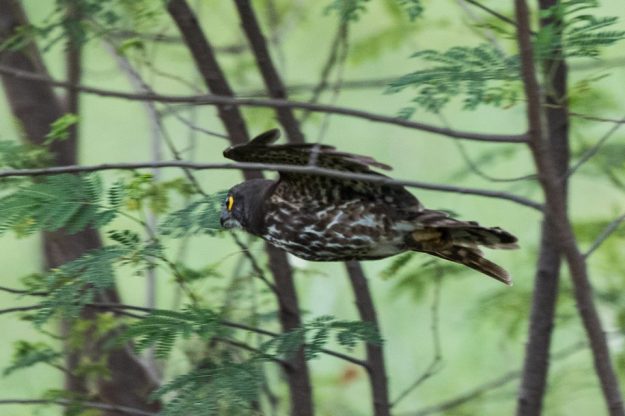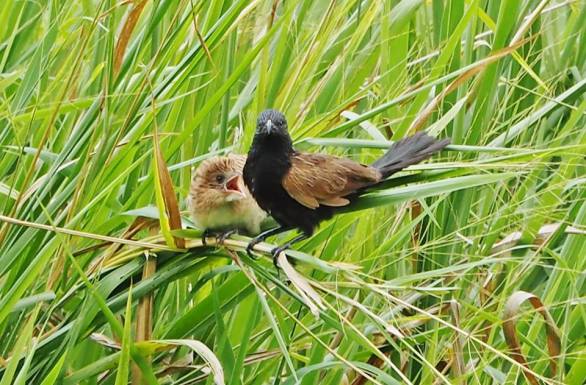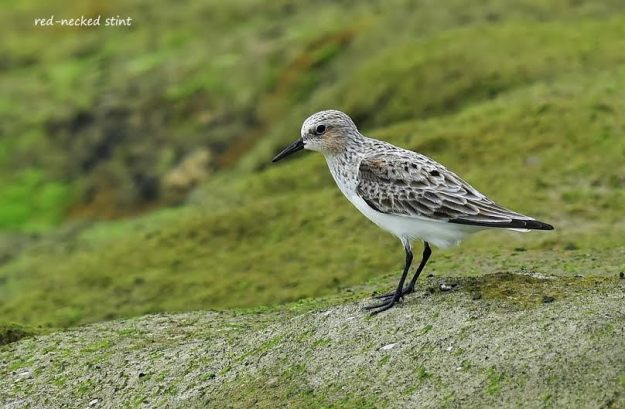April is the tail end of the Spring migration for most of our winter visitors. Many still make a stop over at Bidadari, on their way back. Just shows how important the place is for these migrants. Unfortunately parts of Bidadari have been boarded up for tree cutting and road works. Will we see them again next year? The other location where most migrants made their pit stops is at Tuas South, a site we have not previously checked.

One of the rare photos of a Frigatebird taken within Singapore. Photo: James Tann.
The surprised find for the month was a juvenile Frigatebird photographed flying over the Johor Straits by Birder Dawn, James Tann, Roger Boey and CP Lee on 26th during a boat trip to look for the Brown Booby (last seen on 16th). The juvenile Christmas and Lesser Frigatebirds are hard to separate but the votes so far are for the Christmas, Fregata andrewsi.

The Indian Pond Heron returning to Bidadari this year for the many of us. Photo: Lee Tiah Khee.
There is a high probability that the Indian Pond Heron, Ardeola grayii, found by Keita Sin at Bidadari on 6th could be the same bird that visited Bidadari last year. This time it stayed until 19th giving those who missed it last year an easy tick. Migrants reported from Bidadari this month included a Chestnut-winged Cuckoo, Clamator coromandus, on 1st (Lim Kim Keang), a breeding male Yellow-rumped Flycatcher, Fecedula zanthopygia, on 2nd (Lawrence Cher), Crow-billed Drongo, Dicrurus annectans, on 15th (Chuin Ming Lee) and a Large Hawk Cuckoo, Hierococcyx spaverioides, on 16th (Christopher Lee). Other notable sightings were a non-breeding visitor Crested Serpent Eagle, Spilornis cheela, on 8th (Lim Khee Ming) and two wandering Red-wattled Lapwings, Vanellus indicus, on 11th (Zacc HD).

A probable migrating Northern Boobook found by Koh Lian Heng at Tuas South on 21st April.
Over at Tuas South, it was flycatchers galore. Koh Lian Heng had the rare Japanese Paradise Flycatcher, Terpsiphone atrocauda, on 1st, our second record for the year and a Mugimaki Flycatcher, Ficedula mugimaki, on 7th. Lim Kim Keang recorded three Yellow-rumped Flycatchers, two globally threatened Brown-chested Jungle Flycatchers, Cyornis brunneata on the 2nd. On the same day, he also found a Chestnut-winged Cuckoo, an Indian Cuckoo, Cuculus micropterus and a Hooded Pitta, Pitta Sordida there on the 9th. An adult Tiger Shrike, Lanius tigrinus, was reported on 3rd by Robin Tan and another at Bidadari by Keita Sin on 21st. Interestingly the adult Tigers do not stop over during the Autumn migration. Koh Lian Heng was rewarded for the time he spent at Tuas with a Forest Wagtail, Dendronanthus indicus, on 18th, Eye-browed Thrush, Turdus obscurus, on 19th and a Hawk Owl with non heart-shaped belly markings on 21st, a possible candidate for the Northern Boobook, Ninox japonica.

Barn Swallow sub species mandschurica new for Singapore. Photo: Lena Chow.
On the 3rd Lena Chow photographed a Barn Swallow Hirundo rustica, with a light rufous underparts at Punggol Barat. It was identified by Lim Kim Seng as a mandschurica sub species, new for Singapore but recorded in NW Thailand. A day earlier a Hooded Pitta was spotted at Central Catchment Forest by Manawa Ranasinghe and photographed by Khong Yew (Photo below).

You can just make out one of the pin feather of this snipe at Chinese Gardens. Photo: Koh Lian Heng.
Koh Lian Heng managed to photograph the pin feather of the Chinese Gardens snipe on 7th, giving us a confirmed Pintail Snipe, Gallinago stenura, while Dean Tan flushed a Large Hawk Cuckoo at SBWR on 10th. A single Oriental Pratincole, Glareola maldivarum, was reported at Punggol Barat by Tan Julin on 10th, a returning Ashy Drongo, Dicrurus leucophaeus, to Mount Faber by Joyce Chia on the evening of the 11th, another Indian Cuckoo at DFNP on 26th by Art Toh and a vocal Blue-winged Pitta, Pitta moluccensis, at Kranji Marshes photographed by Adrian Silas Tay and James Tann on 30th. Another Blue-winged Pitta have been wintering at the Singapore Botanic Gardens for a large part of April and is still there on 3rd May ( Richard White).

Hooded Pitta making a stop over at the Central Catchment Forest. Photo: Khong Yew.
Two non-breeding visitors that were seen this month were a Crested Serpent Eagle at Kent Ridge Park on 1st (Keita Sin) and a Jambu Fruit Dove, Ptilinopus jambu, over at Jelutong Tower on 23rd (Nicholas Tan).
As for our uncommon residents, the sightings were quite diverse. A Pacific Reef Egret, Egretta sacra, was photographed at SBWR by Andrew Chow on 1st, Red-crowned Barbet, Megalaima rafflesii, at DFNP on 10th and 11th (Lim Kim Keang and Alan OwYong), another Lesser Adjutant, Leptoptilos javanicus, a former resident was photographed by Francis Yap over at Poyan on 16th, Green Imperial Pigeon, Ducula aenea, at Loyang on 16th (Lim Kim Keang), a Blue-eared Kingfisher Alcedo meninting, was reported by Phay SC at Lower Peirce Boardwalk on 18th, two Great-billed Herons, Ardea sumatrana, at the fish farms at Johor Straits photographed by James Tann on 26th and a Cinnamon Bittern, Ixobrychus cinnamomeus, two Lesser Whistling Ducks, Dendrocygna javanica,at the Seletar Pond by Zacc HD and a male Violet Cuckoo, Chrysococcyx xanthorhynchus, feeding on a fig tree at Kent Ridge Park by Keita Sin on 30th.

Lawrence Cher’s classic photo of a Common Iora feeding a newly fledged Banded Bay Cuckoo.7 April 2016 Lorong Halus

Lesser Coucals nest in thick grasses close to the ground. A great open shot of parent and chick by Terence Tan from Bidadari on 20th April 2016
Several successful fledglings were reported this month. A male Common Iora, Aegithina tiphia, was photographed feeding a Banded Bay Cuckoo, Cocomantis sonnerati, at Lorong Halus on 7th (Lawrence Cher), Malayan Pied Fantail, Rhipidura javanica at PRP on 30th (Seng Alvin), Lesser Coucal, Centropus bengalensis, at Bidadari on 20th (Terence Tan), Greater Racket-tailed Drongo, Dicrurus paradiseus, at One-North on 17th and Buffy Fish Owl, Ketupu ketupu, at SBWR on 25th (both by Alan OwYong).

Red-necked Stint a first for Marina Barrage. Photo: Laurence Eu.
Laurence Eu photographed a Red-necked Stint, Calidris ruficollis, at the Marina Barrage breakwaters on the 14th, a first for the site. He was back again on 25th and got this photo of a Common Sandpiper, Actitis hypoieucos, with a single black band on its leg. David Li checked with his Flyway Group and found that it was banded in Jogjakarta way back in 2008, our first evidence of a shorebird from the south making a stop over on way back north. A great find!

Common Sandpiper banded in Jogjakarta in 2008. Photo: Laurence Eu.
Reference:
Lim Kim Seng. The Avifauna of Singapore. 2009 Nature Society (Singapore).
Yong Ding Li, Lim Kim Chuah and Lee Tiah Khee. A Naturalist’s Guide to the Birds of Singapore. 2013. John Beaufoy Publishing Limited.
Craig Robson. A field Guide to the Birds of Thailand and South East Asia. 2000.
This report is compiled by Alan OwYong and edited by Tan Gim Cheong from selected postings in various facebook birding pages, bird forums and individual reports. Some were not verified. We wish to thank all the contributors for their records. Many thanks to James Tann, Lee Tiah Khee, Koh Lian Heng, Lena Chow, Khong Yew, Lawrence Cher, Terence Tan and Laurence Eu for the use of their photos.
SBWR – Sungei Buloh Wetland Reserve, PRP – Pasir Ris Park, DFNP– Dairy Farm Nature Park.





















